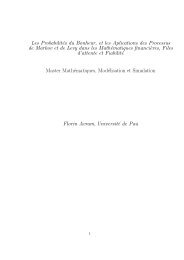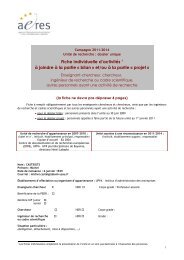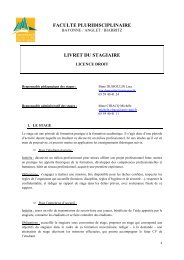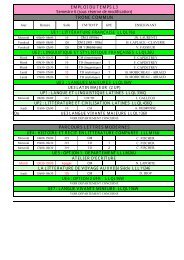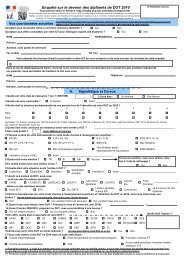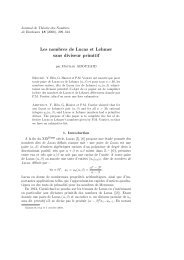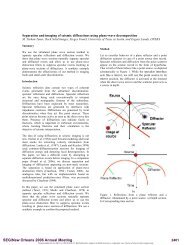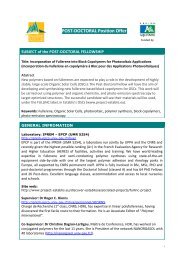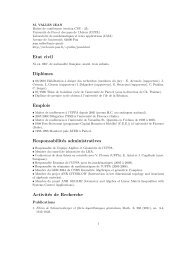Processus de Markov, de Levy, Files d'attente, Actuariat et Fiabilité ...
Processus de Markov, de Levy, Files d'attente, Actuariat et Fiabilité ...
Processus de Markov, de Levy, Files d'attente, Actuariat et Fiabilité ...
You also want an ePaper? Increase the reach of your titles
YUMPU automatically turns print PDFs into web optimized ePapers that Google loves.
FILES D’ATTENTE, FIABILITÉ, ACTUARIAT<br />
Exercise 1.1 Montrez que si Y t est un processus <strong>de</strong> <strong>Levy</strong>, alors :<br />
a) m(t) := EY t satisfait m(t + s) = m(t) + m(s)<br />
b) v(t) := VarY t satisfait v(t + s) = v(t) + v(s)<br />
c) Etablissez la linearité <strong>de</strong> ces fonctions : m(t) = tEY 1 , v(t) = tVarY 1 , pour <strong>de</strong>s temps<br />
t rationnels.<br />
En généralisant :<br />
Théorème 2.1.1 Pour chaque t, s ∈ R + :<br />
a) l’esperance d’une marche aleatoire/processus <strong>de</strong> <strong>Levy</strong> X t avec X 0 = 0 m(t) = EX t<br />
satisfait :<br />
m(t + s) = m(t) + m(s), m(t) = tm(1)<br />
b) la variance v(t) = E(X t − e t ) 2 satisfait :<br />
v(t + s) = v(t) + v(s), v(t) = tv(1)<br />
c) La fonction génératrice <strong>de</strong>s moments d’un processus <strong>de</strong> <strong>Levy</strong> X t avec X 0 = 0 M(t) =<br />
M θ (t) := Ee θXt satisfait :<br />
M(t + s) = M(t) M(s)<br />
pour chaque t, s où elle est bien <strong>de</strong>finie.<br />
d) Déduisez qu’elle doit être <strong>de</strong> la forme : M(t) = e tκ(θ) pour une certaine fonction κ(θ)<br />
(appellée exposant <strong>de</strong> <strong>Levy</strong>, où fonction génératrice <strong>de</strong>s cumulants).<br />
Note : La fonction génératrice <strong>de</strong>s cumulants characterise uniquement un processus <strong>de</strong><br />
<strong>Levy</strong>.<br />
Solution 1.1<br />
Solution 1.2 a) (b)) We <strong>de</strong>compose Y (t + s) = Y (s) + (Y (t + s) − Y (s)) and taking<br />
expectations (variances) we find that both fonctions satisfy the property f(t+s) = f(t)+f(s)<br />
which implies linéarité.<br />
c) The in<strong>de</strong>pen<strong>de</strong>nce and stationarity of increments of a processus <strong>de</strong> <strong>Levy</strong> imply that<br />
M(t) = Ee θYt satisfies the i<strong>de</strong>ntity M(t + s) = M(t) M(s). Taking logarithms we find that<br />
f(t) = LogM(t) satisfies the i<strong>de</strong>ntity f(t + s) = f(t) + f(s).<br />
Finalement, pour conclure la linearité, on s’appuie sur :<br />
Lemma 2.1.1 Si une fonction continue (en fait, mesurable suffit) f(t) : R + − > R satisfait<br />
pour chaque s, t, l’i<strong>de</strong>ntitè :<br />
f(t + s) = f(t) + f(s)<br />
alors f(t) est une fonction linéaire, i.e.<br />
f(t) = f(1)t.<br />
2.2 Exemples <strong>de</strong> processus <strong>de</strong> <strong>Levy</strong><br />
Nous avons <strong>de</strong>ja vu le processus <strong>de</strong> Poisson, <strong>et</strong> le processus <strong>de</strong> Poisson composé S t =<br />
∑ Nt<br />
i=1 Z i, où Z i sont <strong>de</strong>s variables aléatoires i.i.d.(in<strong>de</strong>pen<strong>de</strong>ntes <strong>et</strong> idéntiquement distribuées)<br />
<strong>et</strong> N t est un processus <strong>de</strong> Poisson, in<strong>de</strong>pendant <strong>de</strong> Z i . Un autre exemple est le processus <strong>de</strong><br />
réserves classique (d’une compagnie d’assurance).



